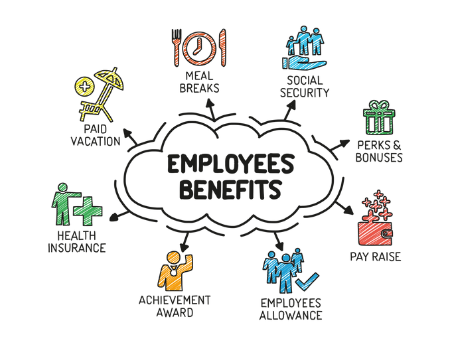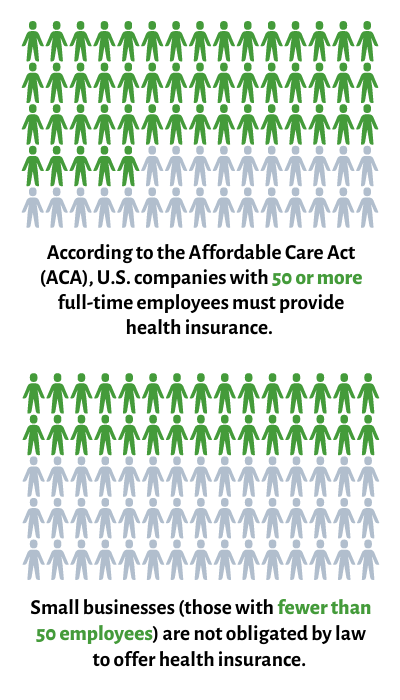What employees expect from employee benefits packages
 Offering an attractive employee benefits package helps lure top talent and encourages the retention of your best team members. Workers consider these “perks” when evaluating their total compensation. Presenting a good benefits package often gives one employer an edge over another, especially in cases where basic salaries are relatively equal.
Offering an attractive employee benefits package helps lure top talent and encourages the retention of your best team members. Workers consider these “perks” when evaluating their total compensation. Presenting a good benefits package often gives one employer an edge over another, especially in cases where basic salaries are relatively equal.
Many types of employee benefits are rather standard. People expect to see them as part of the overall employee benefits package in one form or another. Someone definitely could view a benefits package that lacks health insurance or paid sick days as a reason to not accept an offer of employment. On the flip side, going beyond minimum expectations in such areas quickly separates your business from the crowd and can improve the strength of your job offer. You may even consider offering benefits to part-time employees after being with the company for a certain period of time.
Likewise, including some not-as-common perks can catch attention. If, for example, your goal is to attract Millennial candidates, offering fringe benefits like student loan repayment assistance might prove a great selling point.
So, what should a modern employee benefits package look like? There’s no one-size-fits-all answer. It depends on your company’s objectives and budget. To aid in the decision-making process, though, here’s a closer look at various types of employee benefits.
Health insurance
Despite the emergence of the healthcare marketplace, people still look to their employer as the first and most cost-effective choice for medical insurance. In fact, studies show that 55 percent of full-time employees say that health insurance is the most important benefit they receive and that a quality health insurance plan is a key to job satisfaction.
According to the Affordable Care Act (ACA), U.S. companies with 50 or more full-time employees must provide health insurance. Small businesses (those with fewer than 50 employees) are not obligated by law to offer health insurance. However, many small businesses choose to do so anyway. They see it as an investment in the well-being of their employees and a competitive necessity for attracting and keeping top talent.
Anybody who has ever looked at healthcare plans knows they vary considerably. Legally, employers required to offer health insurance must provide at least a minimum value health insurance plan. To qualify as such, the government states the plan must “pay at least 60% of the total cost of medical services for a standard population” and “include substantial coverage of physician and inpatient hospital services.”
Health benefits to include

Employers looking to impress with their employee benefits package go beyond this basic level of health benefits. Efforts might include:
- Greater choices from which to pick, such as both HMOs and PPOs.
- Medical plans with no or low-cost deductibles.
- Insurance that is accepted at a greater range of places.
- The company paying a higher portion of the insurance premium.
- Outstanding pharmaceutical and/or hospitalization coverage.
- Extensive maternity care.
- Plans that cover things oftentimes not found in standard policies, such as fertility treatments, acupuncture, gender reassignment surgery, or chiropractor visits.
- Dental insurance and vision insurance.
A survey shows that many employers are increasing the amount they spend on telemedicine. Virtual office visits thrived during the COVID-19 pandemic as people sought a safe, quick way to obtain medical information and evaluation. People found out they liked the convenience of telehealth and the care received. This was especially true if their employer offered the service free or at a low cost.
Wellness
Modern employee benefits packages cater to more than just physical wellness. The pandemic especially highlighted the need for mental health services and stress reduction.
A large number of packages include access to an EAP (Employee Assistance Program). This wellness perk provides free mental health assessment, short-term counseling, and referrals for further help.
Other wellness initiatives sometimes include:
- On-site yoga classes.
- Seminars on stress relief, sleep improvement, relaxation, and work-life balance.
- Reimbursement for meditation app subscriptions.
- Employee discounts on gym memberships.
Worker’s compensation and similar measures
Employees like the comfort of knowing that protections exist should something happen to them. Employee benefits plans commonly include worker’s compensation and disability insurance to ensure a sick or injured employee receives at least a portion of his regular pay until able to return to work. What an employer must offer in terms of worker’s compensation and disability varies by state, so human resources should keep tabs on requirements.
Organizations also frequently provide employees with free or low-cost life insurance. These policies provide workers with peace of mind that their loved ones will receive funds to use toward funeral costs and living expenses in the event of the policyholder’s death.
Time off
Smart employers know that sometimes being away from the office can be in everyone’s best interest. Paid sick days encourage ill workers to stay home. Employees recover more quickly, and the chances of infecting other staff members decrease.
Likewise, paid vacation days offer the opportunity for workers to recharge. They come back to the office more refreshed and productive.
Many organizations no longer distinguish between sick days and vacation days. Rather, their employee benefits package puts them together under PTO (paid time off). Such an arrangement keeps workers from faking sickness in order to take a day off. It also enables an employee to take mental health days without the need to go into reasons for the absence.
Generous PTO certainly can excite prospective candidates and existing employees. Some companies even construct unlimited PTO policies that allow employees to take as much time off as they want as long as doing so won’t disrupt the business.
Millennials and many other workers nowadays look for companies committed to making the world a better place. Including a certain number of paid days off for employees to perform volunteer work is a type of employee benefit that generates good vibes in the workplace and catches the eye of new top talent.
Retirement plans
While salary is usually considered the star of compensation packages, employees also realize retirement benefits and plans contribute to their overall financial well-being. Large and small businesses alike benefit from sponsoring plans such as 401(K)s and Simple IRAs. These allow employees to save for their golden years while enjoying tax benefits now.
A primary attraction is employer contributions to retirement savings plans, with the more the better from a worker’s perspective. Some organizations make regular deposits based on a certain percentage of an employee’s salary. Others match funds (up to a certain amount) that the employee elects to save.
Stories about the need to plan ahead for retirement appear frequently in the news. To the average person, though, the process may seem confusing or anxiety-provoking. Thus, people value professional guidance on setting up accounts, exploring investment options, and determining how much to save. If retirement seminars or access to free one-on-one retirement planning sessions are part of your employee benefits package, tout it!
Other financial perks in employee benefits packages
Beyond retirement plans, employers should explore other things they can offer to help employees benefit monetarily. Some companies turn to profit-sharing or stock options as a way of adding compensation beyond salary. Others may cover professional development expenses such as membership dues, certification tests, or tuition reimbursement.
Employers also may want to explore benefit plan additions such as:
Flexible Spending Accounts
An FSA lets a worker elect for his employer to take money directly out of each paycheck to put in an account designated for paying various out-of-pocket medical expenses. The employee saves money because this set-aside money is not taxed. The IRS sets the maximum amount an employer may let the individual contribute within an FSA plan year (currently $2,750).
Health Savings Accounts
People enrolled in a High Deductible Health Plan (HDHP) can set aside paycheck money on a pre-tax basis to pay for qualified medical expenses. Employers also may contribute to this sum. Since the money in the account rolls over each year, some people choose to sock money into this account tax-free to use during retirement when medical expenses may become more substantial.
Commuter benefits
Similar to an FSA, the IRS allows employers to set up accounts designed to pay commuting costs. Workers can voluntarily contribute pre-tax wages (currently up to $270 a month) to a fund that pays for public transportation and certain parking costs. In an effort to help the environment by getting more vehicles off the road, employers in New York City and some other areas are required by law to offer pre-tax commuter benefit plans.
Student loan repayment assistance
For a recent grad facing a mound of debt, an employee benefits package that includes help with student loan bills can be a godsend. Possibilities include matching contributions, fixed contributions, consolidating, refinancing, and redirecting PTO and vacation pay toward student debt.
For employers interested in adding this type of perk, the time has never been better. The Coronavirus Aid, Relief, and Economic Security Act (CARES Act) include a section that created a temporary tax-free provision for employer-sponsored student loan assistance programs. The employer can make up to $5,250 in tax-free student loan payments for an employee within a year. Both sides win: The employee does not have to pay income tax on this money, and the employer gets a payroll tax exclusion on those funds.
Childcare assistance
Working parents oftentimes struggle to secure affordable, reliable childcare. Companies that realize the stress childcare issues put on families and take helpful action can do wonders for attracting top talent (especially female candidates), raising workplace morale, and securing retention of their best employees.
Larger companies may elect to offer perhaps the most eye-catching childcare perk: on-site daycare. While small businesses usually lack the money and space to put that in their benefit plan, they can consider family-friendly actions such as:
- Full or partial childcare subsidies.
- Complimentary emergency childcare services through a contracted provider.
- Flexible employee schedules/work-from-home options.
- DCFSAs: Dependent Care Flexible Spending Accounts (setting aside pre-tax dollars from an employee’s paycheck to use toward paying daycares, preschools, nannies, etc.).
- Generous parental leave policies.
Consider looking out for “furry kids” too. Pet insurance has developed into one of the fastest-growing workplace perks. And with the number of households that added a pet during the pandemic, demand for this type of employee benefit looks to remain high.







